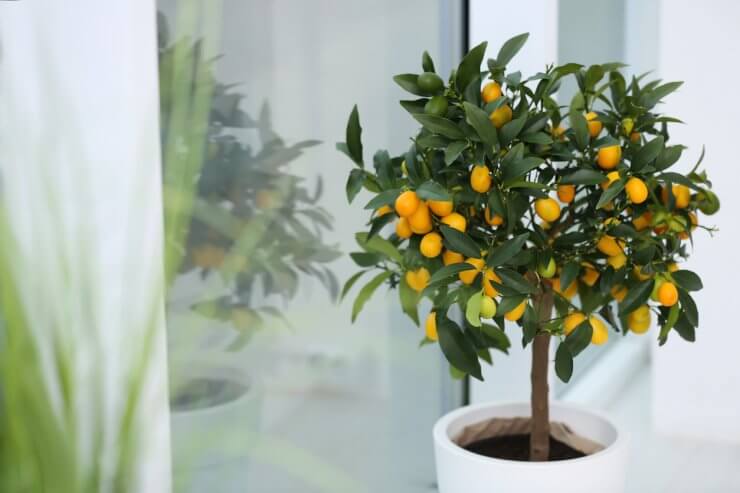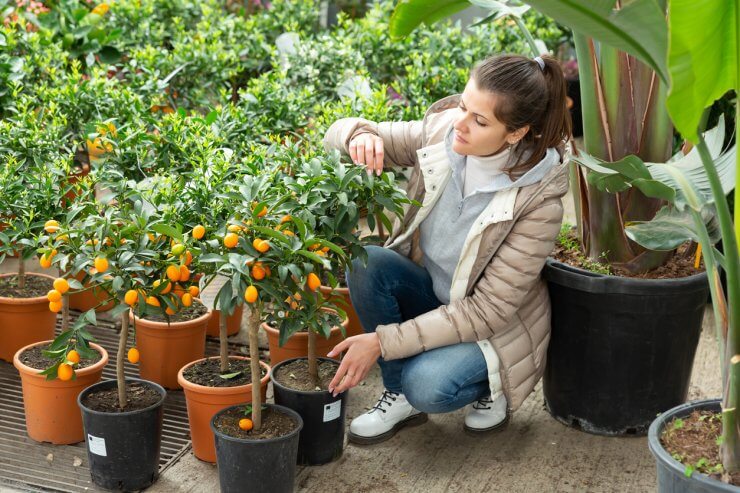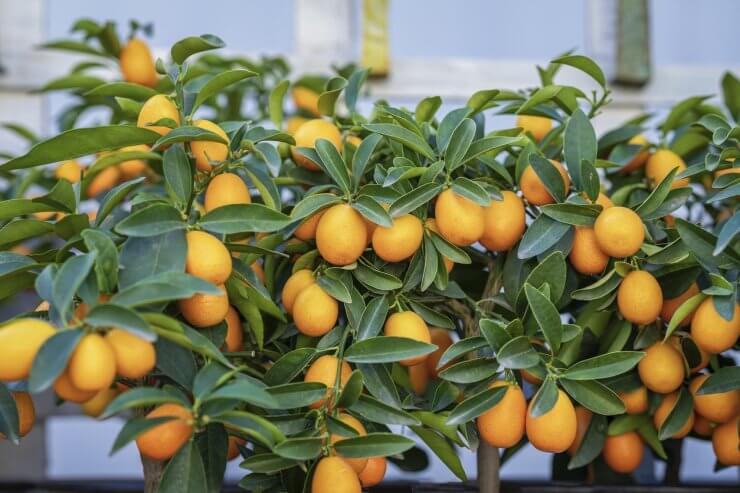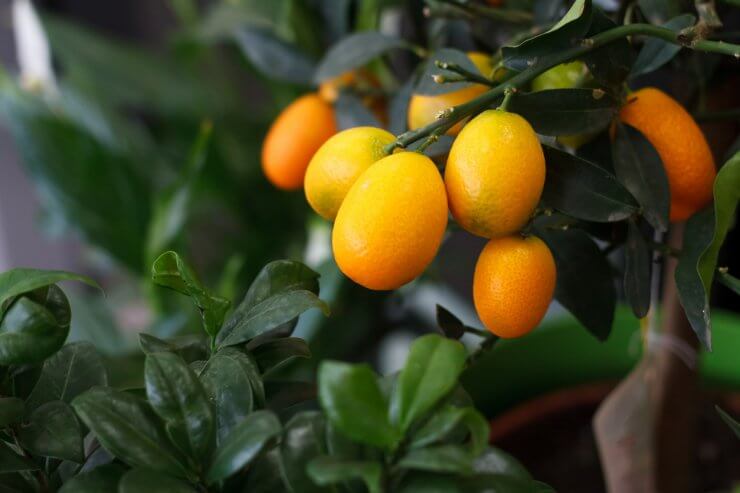If you love kumquats, or just love the idea of having a little kumquat tree in your sunroom, you might wonder if it’s possible to grow a kumquat tree indoors. After all, if you can grow oranges and lemons indoors in zone four, why not kumquats? And the answer is yes—with some modifications.
In Chinese, kumquat means “golden orange.” Sweet on the outside, tart on the inside, it’s the perfect-size fruit to pick fresh off the tree and pop into your mouth. You may have gotten them at the market, but there’s nothing to compare to the taste of a fresh kumquat warmed by the sun (and they do require a lot of sun!). Most people don’t realize that, unlike oranges, the sweetest part of the kumquat is the skin. It’s full of delicious essential oils that make the kumquat a fragrant, tasty treat.

Kumquats may be small; but what they lack in size they more than make up for in flavor and health benefits. Packed to the gills with vitamin C, they’re a great addition to a healthy diet.
While kumquats are ideally suited for USDA plant hardiness zones 9 and 10, they can do well as container plants in cooler zones; in fact, they can handle winter temperatures as low as 15° F!
With a little TLC, you can grow kumquats almost anywhere—as long as you have the right growing conditions, inside or out. Many gardeners in cooler zones move their kumquat trees outside for the warmer months and bring them back in when temperatures start to fall. So, if you love the taste of kumquats but haven’t tried growing a kumquat tree indoors yet, follow our advice below.

Should You Grow from Seed, Cuttings, or Young Trees?
First things first—let’s talk about what to grow if you’re going to grow a kumquat tree indoors.
Seed: It is possible to grow a kumquat tree from seed, but we strongly recommend you don’t. It may not grow true to seed. It will also take years for you to get a sapling of a sufficient size to be able to support the weight of producing fruit. And if you planted from seed and the tree doesn’t grow true to seed—well, you may be disappointed.
Cuttings: Growing from cuttings is possible, but not a sure thing. Better to explore your small tree options at the local nursery.
Young Trees: Kumquat trees grow best when they’re grafted onto hardy rootstock. Your best bet for a flourishing tree and a successful kumquat harvest is to get yourself a tree. Trees are available in a range of ages and sizes, so you will have the most options—and the highest likelihood of success—if you start with a tree.

Can You Grow Kumquat Trees Indoors?
Zones 9 and 10 are the best zones to grow kumquat trees outdoors, so what about all the other zones?
You can absolutely grow a kumquat tree indoors, but start by choosing kumquat trees that grow well indoors.
For example, the Chang-Shou Kumquat tree, also known as Fukushu, is thought to be a chance hybrid of two other kumquat varieties. It produces fruit slightly larger than Meiwa. It has fewer seeds and a mild, sweet flavor. This is a cold-hardy variety that’s perfect for container growing indoors, topping off at 3-5 feet. The fruit is tasty fresh off the tree, as well as candied.
Seven Tips for Success Growing Kumquat Trees Indoors
Kumquats are easy to plant and grow, and they have fairly simple growing requirements: a sunny spot and good soil drainage. If you want to grow a kumquat tree indoors, here’s a brief summary of everything you need to know—and there’s more in our Crazy for Kumquats! Gardening Guide.
- Provide abundant sunlight. Kumquats need at least 6-8 hours of sunlight a day to develop healthy roots; and they prefer 8-10 hours. If you grow your kumquat trees indoors, make sure they have the sunniest spot in the house. Coming up short on sunlight? Have a grow light handy to keep your tree happy and healthy.
- Try a greenhouse. Kumquats are well-suited to greenhouse production. With a greenhouse, you’ll have plenty of semi-indoor space and a more controlled environment. You could use a greenhouse for your container-planted trees when the weather starts turning chilly, but you still want to let them soak up as much sun as they can.
- Bring your trees outside when it’s warm. If you’re growing your kumquat tree in a container, be sure to put it outside whenever possible; leave it outside if you can. Bring your trees inside when the weather turns cold to protect your tree from roots to tip.
- Make sure to have good drainage. Kumquat trees are pretty flexible when it comes to soil: they’re not picky about pH, but they demand good drainage. Soggy roots lead to root rot which can lead to losing your tree.
- Water accordingly. Water regularly, but not too much. If you stick your finger in the soil and it’s damp 3-4 inches down, you can hold off on watering. A soggy kumquat tree is an invitation to rot and disease.
- Self-pollinate as needed. Pollination is essential to fruit growth; it occurs when pollen is transferred from the male part of flowers (anthers) to the female part of the flowers (stigma). Kumquat trees are self-pollinating, which means you only need one tree to get fruit. Now, the tree still needs to get pollinated—by bees, butterflies, or other beneficial insects. If you’re growing your tree in a container indoors, you’re less likely to have butterflies flitting from flower to flower, so you can help your tree along its path to fruiting by acting as its pollinator. Get a small, soft paintbrush to transfer pollen from flower to flower. Or, let it hang outdoors when it’s warm!
- Fertilize in February, May, and August. For a container-grown kumquat tree, you can’t fertilize beyond the tree’s canopy, since the soil has a defined boundary. But it’s still important to establish a fertilizing schedule—February, May, and August work for potted trees. Just as with an outdoor-planted tree, use a fertilizer formulated especially for citrus trees. Top-dress the soil, being sure to water before and after applying fertilizer. Don’t get any fertilizer on the tree itself—only on the soil. In the spring, a slow-release citrus fertilizer is a good choice to keep your tree healthy. As it grows, you can occasionally give it a treat of diluted liquid fertilizer, such as fish emulsion or liquid kelp.

How Long Does it Take for a Kumquat Tree to Bear Fruit Indoors?
From seed to tree, smaller kumquat trees might take only a year to bear fruit, but larger trees will take up to five years. Kumquats tend to ripen in late winter or early spring, even if you’re growing your kumquat tree indoors. The skin will be a deep orange, and the fruit will be slightly soft to the touch. Use a knife or pruning scissors to cut the fruit from the tree so you don’t damage fruit or tree.
Once your kumquat trees start to produce fruit, in most cases you can leave the kumquats on the tree until you’re ready to eat them. But be prepared to have a lot of kumquats! You might want to plan to harvest them every day, unless you want to enjoy the beautiful contrast between the leaves and fruit. Some mature trees can produce a thousand kumquats or more per season.
To get the most out of eating a kumquat, be sure to roll it between your fingers to start releasing the oil. Then, if it’s a smallish kumquat, pop it in your mouth and chew—really chew—to release more of the sweet essential oil to blend with the more tart-tasting flesh inside. If you get a seed, just spit it out (as mentioned above, don’t bother trying to start growing a kumquat tree indoors by seed, it rarely works and it’ll take forever!)
Start Growing Kumquats at Home
Home gardeners love having kumquats around—they even make great container plants! With our Crazy for Kumquats! Gardening Guide, you’ll have everything you need to know about growing and enjoying this delicious food. From the history and background of the “golden orange” to specific advice about soil requirements and fertilizer … from watering techniques to details about avoiding root rot … from easy-to-make and delicious recipes that will allow you to enjoy the fruits of your gardening labor to the nutritional benefits of kumquats—get it all in the Crazy for Kumquats! Gardening Guide right now!


 Previous
Previous


I have been growing citrus in pots for years, now liv ng in western PA. You don’t mention any pests that are common for those growing citrus. Scale is a big one. I have found growing citrus inside in colder climates puts them in warm dry rooms,, not ideal in my experience. I keep mine in an unheated garage under a shop light with the brightest florescent tubes available. I lost my Kumquat this past year finding them a bit finicky compared to lemons and limes.